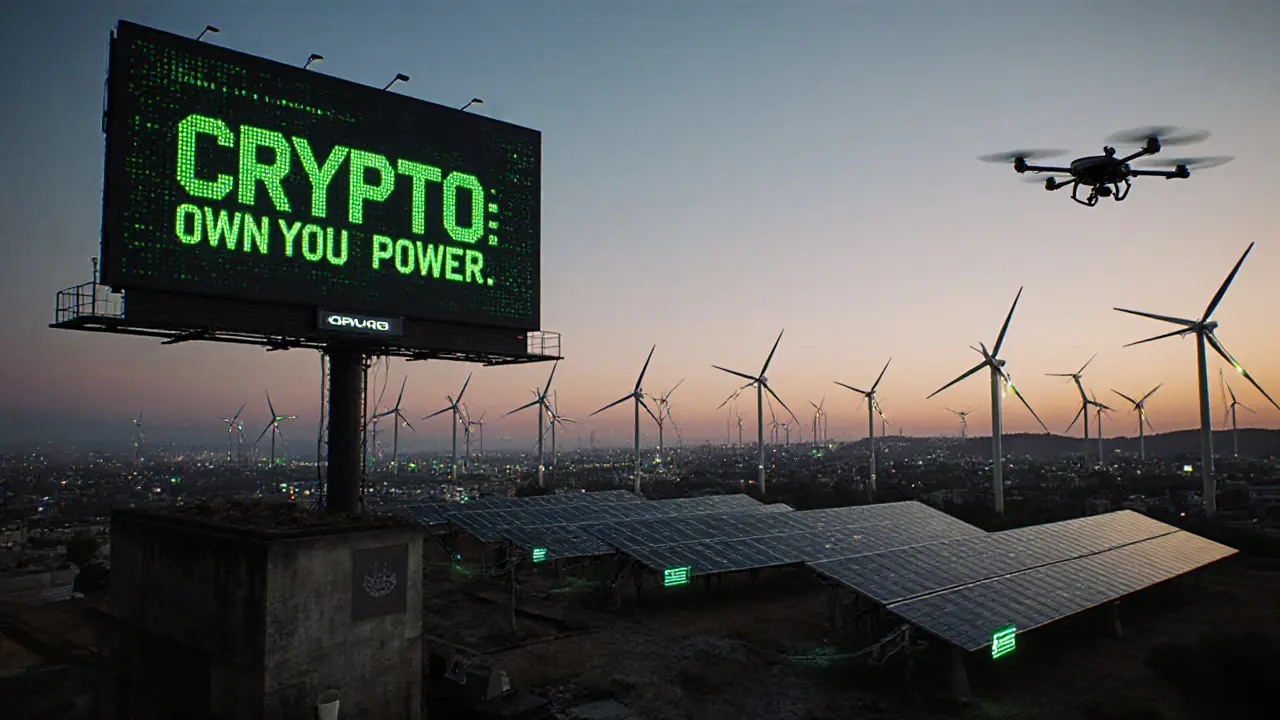Kosovo Energy Calculator
Calculate how many mining rigs consume energy compared to household needs. Kosovo's 2022 ban was triggered when mining operations used over 40% of national electricity. This tool shows the real-world impact of crypto mining.
Your Energy Impact
Total Energy Used
= Enough for - households
Monthly Cost
= -
On January 4, 2022, Kosovo shut down its entire cryptocurrency mining industry overnight. No warning. No grace period. Just police raids, seizures of mining rigs, and a total ban on using the national power grid for digital currency production. The reason? The country was running out of electricity.
Kosovo, a small nation of just 1.8 million people, was already struggling to keep the lights on. One of its two main coal plants had shut down. Power imports were expensive and unreliable. Winter was coming. And in the northern towns, where unemployment was high and wages low, hundreds of people had turned to crypto mining as a lifeline. They weren’t just hobbyists-they were running warehouse-sized operations, using cheap or free electricity to mine Bitcoin and other coins. Some were making up to €2,000 a month-five times the average income. But the cost wasn’t just financial. It was national.
The government didn’t have a law against crypto mining. There wasn’t even a clear definition of it in their books. But they had a grid that was failing. So they acted. The acting Economy Minister, Artane Rizvanolli, signed an emergency order. Within days, authorities confiscated over 1,500 mining machines across the country. Each rig cost between €20,000 and €30,000. For many miners, it was their entire life savings-gone in one sweep.
Why Crypto Mining Drained Kosovo’s Power Grid
Crypto mining isn’t like browsing the web or streaming videos. It’s a constant, energy-hungry process. Machines-called ASICs-run 24/7, solving complex math problems to validate transactions on networks like Bitcoin. Each machine uses as much power as a small refrigerator, but doesn’t stop. A single large mining farm can draw the same amount of electricity as a small town.
In Kosovo, where electricity was subsidized and poorly monitored, miners didn’t pay for what they used. In some cases, they didn’t even have meters. They tapped directly into the grid. In the northern Serb-majority regions, where state control was weaker, mining became a shadow economy. Local officials turned a blind eye. Some even helped. The result? Power outages became common in hospitals, schools, and homes. Families were left in the dark while rigs hummed in basements and warehouses.
According to University of Cambridge data, only 39% of Bitcoin mining globally runs on renewable energy. The rest-61%-comes from fossil fuels like coal and gas. Kosovo’s grid was already 90% coal-powered. Adding mining didn’t just strain the system-it made it dirtier.
The Ban Wasn’t the End-It Was a Turning Point
By mid-2023, the immediate crisis had passed. Power imports stabilized. The grid recovered. But the ban stayed. Why? Because the government realized they couldn’t just go back to how things were.
Instead of lifting the ban, they rewrote the rules. In 2024, Kosovo’s parliament began moving toward a new law-one that doesn’t ban crypto mining outright, but bans it from using the public grid. The message was clear: if you want to mine, find your own power. Solar panels. Wind turbines. Private generators. Even imported renewable energy. But don’t touch the national grid.
Mimoza Kusari-Lila, who led the parliamentary working group on cryptocurrency legislation, said the goal wasn’t to kill innovation. It was to control it. “We’re not against crypto,” she said. “We’re against theft. We’re against chaos.”
Now, miners who want to operate legally must register their equipment, prove their power source, and pay taxes on earnings. The law is still being finalized, but it’s over 90% complete. The European Commission stepped in to make sure the rules meet anti-money laundering standards. Kosovo doesn’t want to become a haven for illicit crypto flows. It wants to be seen as a responsible player.

What’s the Real Impact Today?
The ban wiped out hundreds of jobs and destroyed millions in equipment value. But it also forced a reckoning. Some miners left the country. Others moved underground. A few adapted.
There are now small, legal mining operations in Kosovo-run by tech-savvy entrepreneurs who installed solar arrays on their rooftops or partnered with rural wind farms. One company in Prizren runs a 50-kilowatt mining farm powered entirely by solar panels. They pay for their own electricity, register with authorities, and file monthly tax reports. It’s not profitable like it was in 2021-but it’s legal. And it’s growing.
Meanwhile, the black market still exists. Smuggled rigs show up in border towns. Power theft is still reported. But enforcement has gotten tighter. Cameras monitor high-risk areas. Electricity meters are being upgraded nationwide. The government is even using blockchain itself to track energy usage-ironic, given the target of the ban.
How Kosovo Compares to the Rest of the World
Kosovo isn’t alone. In 2021, China banned crypto mining outright, shutting down nearly 75% of the world’s Bitcoin mining capacity overnight. Kazakhstan cracked down after a surge in demand caused rolling blackouts. Russia has fluctuated between bans and tax schemes. In 2024, at least eight countries had full or partial mining bans.
But Kosovo’s approach is unique. Most bans are permanent. Kosovo’s is conditional. It’s not about stopping crypto. It’s about stopping the abuse of public resources. That’s a model other energy-stressed nations are watching closely.
Think of it this way: if your neighbor is using your shared power line to run a factory, you’d shut it down. But if they install their own generator and pay for it? That’s fair. Kosovo didn’t ban mining. It banned free-riding.

What’s Next for Kosovo and Crypto?
The next big step is the final passage of the cryptocurrency law. If it passes, Kosovo will become one of the first countries in Europe to create a legal framework that separates crypto mining from the public grid while allowing innovation under strict rules.
There are still challenges. The European Commission’s review has slowed things down. Some lawmakers worry the rules are too strict and will push miners to neighboring countries. Others fear the law won’t be enforced well in remote areas.
But the direction is clear: Kosovo is trying to build a system where crypto mining doesn’t cost the public. Where innovation doesn’t come at the expense of power for hospitals, schools, and homes.
It’s not perfect. It’s not easy. But in a country that once had to ration electricity during winter, it’s the only way forward.
Could This Happen Elsewhere?
Maybe. Countries with aging grids, heavy reliance on coal, or weak energy regulation are at risk. Turkey, Argentina, and parts of Eastern Europe have already seen spikes in mining activity during energy shortages. If power demand outpaces supply, the same pressure will build.
The lesson from Kosovo? Don’t wait for the lights to go out. If crypto mining is growing in your region, ask: who’s paying for it? Is it the grid? The environment? Your neighbors?
There’s no magic fix. But Kosovo proved one thing: you can’t mine your way out of an energy crisis. You have to fix the crisis first.


sandeep honey
November 15, 2025 AT 08:44Kosovo didn't ban crypto mining they banned theft. That's the real story. People were siphoning electricity like it was free water while hospitals flickered. If your neighbor runs a factory off your extension cord you don't negotiate you cut the wire. Simple.
Mandy Hunt
November 16, 2025 AT 05:23They say it was about power but everyone knows the EU made them do it. They don't want crypto because it can't be tracked. This is just the beginning they're coming for your Bitcoin next then your cash then your thoughts. The grid was fine until the deep state decided to control everything
anthony silva
November 18, 2025 AT 04:52Wow Kosovo finally figured out you can't mine Bitcoin with the same power that keeps grandma's oxygen machine running. Groundbreaking. Next up the mayor of Topeka bans people from using their AC during heatwaves because the grid can't handle it. Oh wait that already happened
Sara Lindsey
November 18, 2025 AT 13:59This is actually inspiring. People lost everything but the country chose people over profit. Imagine if every place did that. Solar powered miners. Registered. Taxed. Responsible. We could turn this into a global movement. Imagine clean crypto. Imagine energy justice. Imagine a world where innovation doesn't steal from the vulnerable. This is the future and Kosovo is lighting the way
alex piner
November 20, 2025 AT 06:06Man I feel for those miners who lost everything. But honestly the grid was falling apart. My cousin in rural Kentucky had the same problem when people started mining in barns. The lights kept going out during winter. Kosovo did the hard thing. Now they're building something better. Hope those solar miners are crushing it
Gavin Jones
November 21, 2025 AT 04:49One must admire the principled stance taken by the authorities of Kosovo. It is not often that a nation with limited resources elects to prioritize the welfare of its citizenry over the allure of unregulated technological speculation. The conditional framework now being developed represents a model of regulatory maturity that ought to be studied by other energy-constrained jurisdictions. One can only hope that the European Commission's review does not dilute the integrity of this initiative
Mauricio Picirillo
November 21, 2025 AT 16:46People think crypto mining is just about money but it's really about power. Who gets to use it. Who pays for it. Kosovo didn't say no to tech they said no to stealing. Now folks are building solar rigs and paying taxes. That's not a ban that's a upgrade. Keep going guys you're doing the right thing
Liz Watson
November 22, 2025 AT 12:52Oh wow Kosovo actually did something smart. Shocking. I guess when your country is literally falling into darkness you stop pretending that free electricity for crypto is a sustainable business model. Who knew? Maybe next they'll ban people from using their neighbor's Wi-Fi to stream Netflix
Rachel Anderson
November 23, 2025 AT 17:01Imagine your entire life savings stolen in one night. 1500 rigs gone. Families crushed. And they call it justice? This isn't policy this is a corporate coup disguised as energy reform. The real criminals are the banks and the EU pushing this so they can control every digital transaction. I'm crying for those miners. They were just trying to survive
Hamish Britton
November 24, 2025 AT 16:10My mate in Prizren runs a little solar mine. Says it's barely breaking even now but he's proud. No more blackouts in his village. Kids can do homework at night. He says the law's messy but at least it's honest. That's more than most countries can say. Sometimes the right thing is also the quiet thing